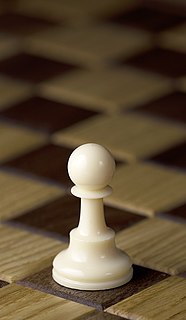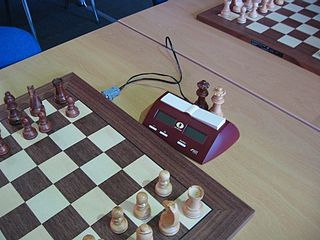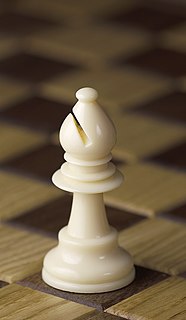Avalanche chess is a chess variant designed by Ralph Betza in 1977. After moving one of their own pieces, a player must move one of the opponent's pawns forward one square.
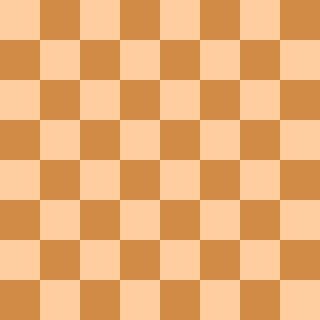
Circe chess is a chess variant in which captured pieces are reborn on their starting positions as soon as they are captured. The game was invented by French composer Pierre Monréal in 1967 and the rules of Circe chess were first detailed by Monréal and Jean-Pierre Boyer in an article in Problème, 1968.

Alice Chess is a chess variant invented in 1953 by V. R. Parton which employs two chessboards rather than one, and a slight alteration to the standard rules of chess. The game is named after the main character "Alice" in Lewis Carroll's work Through the Looking-Glass, where transport through the mirror into an alternate world is portrayed on the chessboards by the after-move transfer of chess pieces between boards A and B.
Progressive chess is a chess variant in which players, rather than just making one move per turn, play progressively longer series of moves. The game starts with White making one move, then Black makes two consecutive moves, White replies with three, Black makes four and so on. Progressive chess can be combined with other variants; for example, when circe is played as a game, it is usually progressively. Progressive chess is considered particularly apt for playing correspondence chess using mail or some other slow medium, because of the relatively small number of moves in a typical game.

Sittuyin, also known as Burmese chess, is a variant of chess that is a direct offspring of the Indian game of chaturanga which arrived in 8th century AD. Sit is the modern Burmese word for army or war ; the word sittuyin can be translated as representation of the four characteristics of army—chariot, elephant, cavalry and infantry.
Marseillais chess is a chess variant in which each player moves twice per turn. The rules of the game were first published in Marseillais local newspaper Le Soleil in 1925. The variant became quite popular in the late 1930s with such chess grandmasters as Alexander Alekhine, Richard Réti, Eugene Znosko-Borovsky, and André Chéron playing it.
Chaturaji is a four-player chess-like game. It was first described in detail c. 1030 by Al-Biruni in his book India. Originally, this was a game of chance: the pieces to be moved were decided by rolling two dice. A diceless variant of the game was still played in India at the close of the 19th century.

Knight Relay chess is a chess variant invented by Mannis Charosh in 1972. In this game knights "relay" their power to friendly pieces.

Dunsany's Chess, also known as Dunsany's Game, is an asymmetric chess variant in which one side has standard chess pieces, and the other side has 32 pawns. This game was invented by Lord Dunsany in 1942. A similar game is called Horde Chess.

Monochromatic chess is a chess variant with unknown origin. The initial board position and all rules are the same as in regular chess, except that pieces that begin on a black square must always stay on a black square and pieces that begin on a white square must always stay on a white square. This would mean that knights can never move, but The Classified Encyclopedia of Chess Variants says that knights make a double jump. It has been suggested that a knight be replaced with a (3,1)-leaper (camel).

Senterej is a regional chess variant, the form of chess traditionally played in Ethiopia and Eritrea. It is the last popular survival of shatranj. A distinctive feature of Senterej is the opening phase – players make as many moves as they like without regard for how many moves the opponent has made; this continues until the first capture is made. Memorization of opening lines is therefore not a feature of the game.
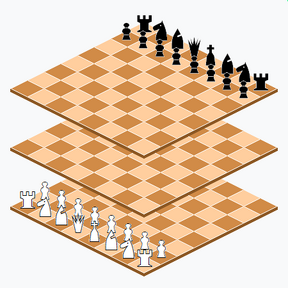
Millennium 3D Chess is a three-dimensional chess variant created by William L. D'Agostino in 2001 which employs three vertically stacked 8×8 boards, with each player controlling a standard set of chess pieces. The inventor describes his objective as "extending the traditional chess game into a multilevel environment without distorting the basic game."

2000 A.D. is a chess variant created by V. R. Parton which employs fairy chess pieces on a 10×10 board. Parton published the variant in his 1972 monograph My Game for 2000 A.D. and After.

Wildebeest Chess is a chess variant created by R. Wayne Schmittberger in 1987. The Wildebeest board is 11×10 squares. Besides the standard chess pieces, each side has two camels and one wildebeest. The inventor's intent is "to balance the number of 'riders'—pieces that move along open lines—with the number of 'leapers'—pieces that jump".

EuroShogi is a shogi variant invented by Vladimír Pribylinec starting in 2000. The game developed from an early version of chess variant Echos in 1977, leading to Cubic Chess, then later to Cubic Shogi, and finally to "EuroShogi". Instead of the classic figures, 18 black and 18 black cubes are used, which are on two opposing sides without symbols. The other two symbols on the opposite sides have one white and one black symbol. The other opposing sides are the same symbols of the opposite color - their promotion is indicated by a red circle around the symbol. Symbol on top of the cube indicates its mobility. The pieces are placed on the board so that they are oriented towards players without any symbolic surfaces. Plays on a board with 8x8 fields of the same color.
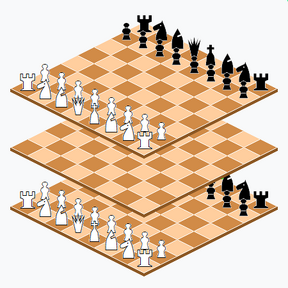
Parallel Worlds Chess is a three-dimensional chess variant invented by R. Wayne Schmittberger in the 1980s. The gamespace comprises three 8×8 chessboards at different levels. Each side commands two full chess armies on levels 1 and 3. Level 2 begins empty and obeys its own move rules.
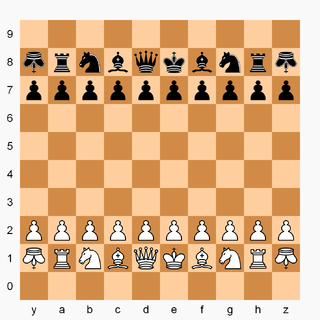
Stratomic is a chess variant invented by Robert Montay-Marsais in 1972. The game is played on a 10×10 board with all the standard chess pieces present, and in addition, two nuclea pieces and two extra pawns per side. The game brings the concept of modern warfare weaponry to chess.

Falcon-Hunter Chess is a chess variant invented by Karl Schultz in 1943 employing the two fairy chess pieces falcon and hunter. The game takes several forms, including variations Hunter Chess and Decimal Falcon-Hunter Chess added in the 1950s.

Hostage Chess is a chess variant invented by John Leslie in 1997. Captured pieces are not eliminated from the game but can reenter active play through drops, similar to shogi. Unlike shogi, the piece a player may drop is one of his own pieces previously captured by the opponent. In exchange, the player returns a previously captured enemy piece which the opponent may drop on a future turn. This is the characteristic feature of the game.

